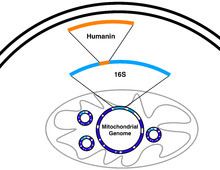 | ||
Humanin is a peptide that is encoded in the mitochondrial genome by the 16S ribosomal RNA gene, MT-RNR2. Its structure contains a three-turn a-helix, and no symmetry.
Contents
The length of the peptide depends on where it is produced. If it is produced inside the mitochondria it will be 21 amino acids long. If it is produced outside the mitochondria, in the cytosol, it will be 24 amino acids long. Both peptides have been shown to have biological activity.
Humanin was independently discovered by three labs looking at Alzheimer's disease, apoptosis, and IGF-1 signaling.
Experiments using cultured cells have demonstrated that humanin has both neuroprotective as well as cytoprotective effects and experiments in rodents have found that it has protective effects in Alzheimer's disease models, Huntington's disease models and stroke models (reviewed in ).
Discovery
Humanin was independently found by three different labs looking at different parameters. The first to publish was the Nishimoto lab in 2001 where they found humanin while looking for possible proteins that could protect cells from amyloid beta, a major component of Alzheimer's disease. The Reed lab found humanin in a screen looking for proteins that could interact with Bcl-2-associated X protein (Bax), a major protein involved in apoptosis. The Cohen lab (Pinchas Cohen) independently discovered humanin when screening for proteins that interact with IGFBP3.
Protective Effects
Humanin is proposed to have myriad neuroprotective and cytoprotective effects. Both studies in cells and rodents have both found that administration of humanin or humanin derivatives increases survival and/or physiological parameters in Alzheimer's disease models. In addition to Alzheimer's disease, humanin has other neuroprotective effects against models of Huntington's disease, prion disease, and stroke. Beyond the possible neuroprotective effects, humanin protects against oxidative stress, atherosclerotic plaque formation, and heart attack. Metabolic effects have also been demonstrated and humanin helps improve survival of pancreatic beta-cells, which may help with type 1 diabetes, and increases insulin sensitivity, which may help with type 2 diabetes.
Mechanism of Action
The beneficial effects of humanin have been proposed to have several different modes of action. Extracellular interaction with a tripartite receptor composed of gp130, WSX1, and CNTFR, as well as interaction with the formyl peptide receptor 2 (formylpeptide-like-1 receptor) have been published. Intracellular interaction with BAX, tBID, IGFBP3, and TRIM11 may also be required for the effects of humanin.
Homologs
The rat, Rattus norvegicus, has a gene, rattin, that encodes a 38 amino acid peptide, which is homologous to humanin. The two genes produce cDNAs that show 88% sequence identity. The peptides are 81% identical, with the carboxyl terminal sequence 14 amino acids longer in rattin. Of the 24 amino acids in the rest of the sequence, 20 are the identical.
Rattin shows the same ability as humanin to defend neurons from the toxicity of beta-amyloid, the cause of degeneration in Alzheimer's Disease.
